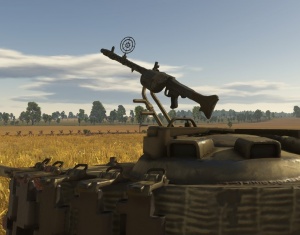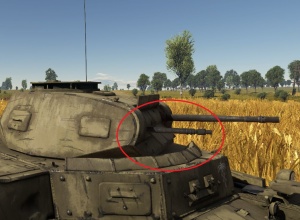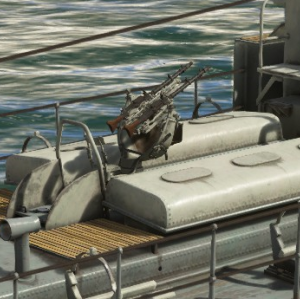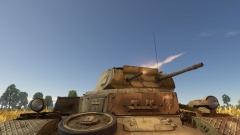Difference between revisions of "MG34 (7.92 mm)"
m (Minor formatting edits, replace instructions, placed in <!-- --> brackets.) |
m |
||
| Line 1: | Line 1: | ||
== Description == | == Description == | ||
<!--''Write an introduction to the article in 2-3 small paragraphs. Briefly tell about the history of the development and combat using of the weaponry and also about its features. Make an air or ground vehicles list on which this weapon is installed in our game.''--> | <!--''Write an introduction to the article in 2-3 small paragraphs. Briefly tell about the history of the development and combat using of the weaponry and also about its features. Make an air or ground vehicles list on which this weapon is installed in our game.''--> | ||
| − | [[File:Pintle Mounted MG 34.jpg|thumb|An example of a pintle-mounted MG 34 with AA sight on a Tiger I.]] | + | [[File:Pintle Mounted MG 34.jpg|thumb|An example of a pintle-mounted '''MG 34''' with AA sight on a Tiger I.]] |
The MG 34 is a recoil-operated, air-cooled machine gun of German origin.<ref name=":0">''Encyclopedia of Weapons of World War II''. p. 246.</ref> Development of the MG 34 began in 1934 by Heinrich Vollmer, eventually seeing service with the Francoist Spanish forces in the Spanish Civil War. Inspired heavily by Rheinmetall's MG 30, changes and developments made to the MG 34 design led it to become the first General-Purpose Machine Gun (GPMG).<ref name=":0" /> The weapon was revolutionary for its time, boasting the highest fire rate of any machine gun at the time.<ref>Haskew, Michael E (2012). ''Small Arms 1914-1945: The Essential Weapons Identification Guide''. London: Amber Books. p. 92. <nowiki>ISBN 978-1-908273-85-7</nowiki>.</ref> Though its technological superiority came at a cost, causing it to be far too expensive and complicated to mass-produce on its own. Thus, it was produced and implemented in tandem with similar machine guns such as the [[MG 42 (7.92 mm)|MG 42]].<ref>''The Encyclopedia of Weapons of World War II''. Chris Bishop. Sterling Publishing Company. 2002. page 245 & 246</ref> | The MG 34 is a recoil-operated, air-cooled machine gun of German origin.<ref name=":0">''Encyclopedia of Weapons of World War II''. p. 246.</ref> Development of the MG 34 began in 1934 by Heinrich Vollmer, eventually seeing service with the Francoist Spanish forces in the Spanish Civil War. Inspired heavily by Rheinmetall's MG 30, changes and developments made to the MG 34 design led it to become the first General-Purpose Machine Gun (GPMG).<ref name=":0" /> The weapon was revolutionary for its time, boasting the highest fire rate of any machine gun at the time.<ref>Haskew, Michael E (2012). ''Small Arms 1914-1945: The Essential Weapons Identification Guide''. London: Amber Books. p. 92. <nowiki>ISBN 978-1-908273-85-7</nowiki>.</ref> Though its technological superiority came at a cost, causing it to be far too expensive and complicated to mass-produce on its own. Thus, it was produced and implemented in tandem with similar machine guns such as the [[MG 42 (7.92 mm)|MG 42]].<ref>''The Encyclopedia of Weapons of World War II''. Chris Bishop. Sterling Publishing Company. 2002. page 245 & 246</ref> | ||
=== Vehicles equipped with this weapon === | === Vehicles equipped with this weapon === | ||
As of update 1.85.0.112, the MG 34 is present on 45 tanks and three naval vessels in War Thunder. It is on 42 German vehicles, 3 German naval vessels, 2 Soviet vehicles, and 1 Japanese vehicle. | As of update 1.85.0.112, the MG 34 is present on 45 tanks and three naval vessels in War Thunder. It is on 42 German vehicles, 3 German naval vessels, 2 Soviet vehicles, and 1 Japanese vehicle. | ||
| − | [[File:A coaxially mounted MG 34 on the Pz.II DAK..jpg|thumb|A Pz.II DAK's MG 34. The MG 34 (circled in red) is the smaller of the two weapons]] | + | [[File:A coaxially mounted MG 34 on the Pz.II DAK..jpg|thumb|A Pz.II DAK's '''MG 34'''. The '''MG 34''' (circled in red) is the smaller of the two weapons]] |
<div style="column-count:2;-moz-column-count:2;-webkit-column-count:2"> | <div style="column-count:2;-moz-column-count:2;-webkit-column-count:2"> | ||
* [[Pz.III B|Pz.Kpfw. III Ausf. B]] (twin coaxial) | * [[Pz.III B|Pz.Kpfw. III Ausf. B]] (twin coaxial) | ||
| Line 66: | Line 66: | ||
=== Available shells === | === Available shells === | ||
<!--''Describe the shells that are available for the cannon and their features and purpose. If it concerns autocannons or machine guns, so write about different ammo belts and what is inside (which types of shells).''--> | <!--''Describe the shells that are available for the cannon and their features and purpose. If it concerns autocannons or machine guns, so write about different ammo belts and what is inside (which types of shells).''--> | ||
| − | [[File:MG34 Naval Mount.png|thumb|The unique mount for the MG 34 on the S-38b.]] | + | [[File:MG34 Naval Mount.png|thumb|The unique mount for the '''MG 34''' on the S-38b.]] |
In War Thunder, the MG 34 is a secondary weapon and thus does not have optional belts. It uses one default belt, consisting of AP-I/AP-I/AP-T for tank battles, and straight AP-I for naval. | In War Thunder, the MG 34 is a secondary weapon and thus does not have optional belts. It uses one default belt, consisting of AP-I/AP-I/AP-T for tank battles, and straight AP-I for naval. | ||
Revision as of 15:55, 1 February 2019
Contents
Description
The MG 34 is a recoil-operated, air-cooled machine gun of German origin.[1] Development of the MG 34 began in 1934 by Heinrich Vollmer, eventually seeing service with the Francoist Spanish forces in the Spanish Civil War. Inspired heavily by Rheinmetall's MG 30, changes and developments made to the MG 34 design led it to become the first General-Purpose Machine Gun (GPMG).[1] The weapon was revolutionary for its time, boasting the highest fire rate of any machine gun at the time.[2] Though its technological superiority came at a cost, causing it to be far too expensive and complicated to mass-produce on its own. Thus, it was produced and implemented in tandem with similar machine guns such as the MG 42.[3]
Vehicles equipped with this weapon
As of update 1.85.0.112, the MG 34 is present on 45 tanks and three naval vessels in War Thunder. It is on 42 German vehicles, 3 German naval vessels, 2 Soviet vehicles, and 1 Japanese vehicle.
- Pz.Kpfw. III Ausf. B (twin coaxial)
- Pz.Kpfw. II Ausf. C (coaxial)
- Pz.Kpfw. II Ausf. F (coaxial)
- Pz.Kpfw. II Ausf. C (DAK) (coaxial)
- Pz.Kpfw. III Ausf. E (twin coaxial)
- Pz.Kpfw. IV Ausf. C (coaxial)
- Pz.Kpfw. III Ausf. F (coaxial)
- Pz.Kpfw. III Ausf. J (coaxial)
- Pz.Kpfw. IV Ausf. E (coaxial)
- Pz.Kpfw. III Ausf. J1 (coaxial)
- Pz.Kpfw. IV Ausf. F1 (coaxial)
- Pz.Kpfw. III Ausf. L (coaxial)
- Pz.Kpfw. IV Ausf. F2 (coaxial)
- Pz.Kpfw. III Ausf. N (coaxial)
- Pz.Kpfw. III Ausf. M (coaxial)
- Pz.Kpfw. VI Tiger Ausf. H1 (coaxial)
- ␠Tiger (coaxial)
- Pz.Kpfw. IV Ausf. G (coaxial)
- Jagdpanzer 38(t) Hetzer (remote)
- Panzerbefehlswagen IV (coaxial)
- 8,8 Pak 43/1 Sf."Nashorn" (twin pintle)
- Pz.Kpfw. VI Tiger Ausf. E (coaxial, pintle)
- Pz.Kpfw. IV Ausf. H (coaxial)
- Pz.Kpfw. IV Ausf. J (coaxial)
- Pz.Kpfw. V Ausf. D (coaxial)
- Pz.Kpfw. KV-IB 756(r) (coaxial)
- Ersatz M10 Panther (coaxial)
- Pz.Kpfw. VI Ausf. B (P) (coaxial)
- Pz.Kpfw. V Ausf. A (coaxial)
- Pz.Kpfw. V Ausf. G (coaxial)
- Jagdpanzer V Jagdpanther (hull)
- Befehlswagen Jagdpanther (hull)
- Pz.Kpfw. VI Ausf. B (H) mit Simmering Sla.16 (coaxial, pintle)
- Pz.Kpfw. VI Ausf. B (H) (coaxial)
- Pz.Kpfw. V Ausf. F (coaxial)
- Panzerbefehlswagen VI (P) (coaxial)
- VK 4501 (P) (coaxial)
- Pz.Kpfw. Panther II (coaxial)
- Pz.Kpfw. VI Ausf. B mit 10.5cm KwK L/68 (coaxial)
- Jagdpanzer VI Jagdtiger (hull)
- E-100 (coaxial)
- Pz.Kpfw. VIII Maus (coaxial)
- T-III (coaxial)
- T-V (coaxial)
- Heavy Tank No.6 (coaxial)
- Schnellboot S-38b
- Schnellboot S-100 (S204) Lang
- Schnellboot S-100 (1945)
General info
The MG 34 is a common sight in War Thunder, being mounted coaxially in many German tank turrets and even on some external Anti-Air and Anti-Infantry mounts. It was found to be better suited to such applications than its counterparts, and quickly became the Wehrmacht's weapon of choice for supplying armour with rifle-calibre protection. It was also used as light-AA on certain Kriegsmarine vessels.
Chambered in 7.92 mm, the MG 34 boasts a fire rate of up to 900 rpm at a velocity of 765 m/s. It can be fed from belts with up to 250 rounds, or drum magazines holding up to 75 rounds.
Available shells
In War Thunder, the MG 34 is a secondary weapon and thus does not have optional belts. It uses one default belt, consisting of AP-I/AP-I/AP-T for tank battles, and straight AP-I for naval.
AP-I Penetration
| Distance | 0° | 30° | 60° |
|---|---|---|---|
| 10 m | 10 mm | 7 mm | 3 mm |
| 100 m | 9 mm | 6 mm | 3 mm |
| 500 m | 7 mm | 5 mm | 2 mm |
| 1000 m | 4 mm | 3 mm | 1 mm |
| 1500 m | 0 mm | 0 mm | 0 mm |
| 2000 m | 0 mm | 0 mm | 0 mm |
AP-T Penetration
| Distance | 0° | 30° | 60° |
|---|---|---|---|
| 10 m | 13 mm | 9 mm | 4 mm |
| 100 m | 12 mm | 9 mm | 4 mm |
| 500 m | 7 mm | 5 mm | 2 mm |
| 1000 m | 4 mm | 3 mm | 1 mm |
| 1500 m | 1 mm | 0 mm | 0 mm |
| 2000 m | 1 mm | 0 mm | 0 mm |
Comparison with Analogues
While having a slower fire rate than the MG 42, both weapons fire the same ammunition at the same velocity, meaning they perform nearly identically. The frequency with which the MG 34 appears means players of the German ground forces will be well-acquainted with the 7.92 calibre which sets the standard for MGs in the German tech tree.
Usage in the battles
Being coaxially mounted is a significant advantage for taking out light vehicles such as SPAA or tank destroyers with an exposed crew. On rare occasion, certain fully-enclosed vehicles have so little armour that they can be penetrated by the MG 34 at close range. If you are lucky enough to be driving a vehicle with a roof-mounted MG 34 such as the Jagdpanzer 38(t), it performs well as a deterrent for attacking aircraft, and might even score you a kill. And as with any other machine gun, it can prove to be a useful tool for spotting enemies for your allies or clearing obstacles.
Pros and cons
Pros:
- High fire rate
- Decent penetration for its calibre
- Common usage means it is easy to be familiar with handling this gun
- Large magazine
Cons:
- Only proves to be deadly against a limited set of targets
- Not commonly mounted externally, limiting its use against aircraft
Historical part
Media
Read also
Links to the articles on the War Thunder Wiki that you think will be useful for the reader, for example,
- reference to the article about the variant of the cannon/machine gun;
- references to approximate analogues by other nations and research trees.
ETC.
Sources
- https://www.scribd.com/document/192297851/D-124-1-Maschinengewehr-34-Teil-1-Waffe
- http://modernfirearms.net/en/machineguns/germany-machineguns/mg-34-eng/
| Tank machine guns | |
|---|---|
| USA | |
| 7.62 mm | M37 · M60D · M73 · M240 · M1919A4 · Mk.52 |
| 12.7 mm | FN M3P · M2HB · M80 · M85 |
| Germany | |
| 5.56 mm | MG4 |
| 7.62 mm | C6 · MG3A1 |
| 7.92 mm | MG13 Dreyse · MG34 · MG37(t) · MG42 |
| 12.7 mm | S.MG.50 |
| USSR | |
| 7.62 mm | DT · PKMB · PKT · PKTM · RP-46 · SGMT |
| 12.7 mm | DK · DShK · 6P49 · NSVT |
| 14.5 mm | KPVT |
| Britain | |
| 7.62 mm | Browning MG4 · L3A1 · L8A1 · L8A2 · L37A1 · L37A2 · L94A1 |
| 7.7 mm | Vickers |
| 7.92 mm | BESA |
| 12.7 mm | L21A1 |
| Japan | |
| 6.5 mm | Type 91 |
| 7.62 mm | Type 74 |
| 7.7 mm | Type 97 |
| 12.7 mm | Type 60 (B) |
| China | |
| 5.8 mm | QJT |
| 7.62 mm | Type 55 · Type 59 · Type 86 |
| 12.7 mm | QJC88A · Type 54 |
| 14.5 mm | QJG02 |
| Italy | |
| 7.62 mm | Beretta MG42/59 · FN MAG 60-40 |
| 8 mm | 34/40M · Breda Mod. 38 |
| 13.2 mm | Breda Model 31 |
| France | |
| 7.5 mm | AAT-52 · MAC 31 |
| 7.62 mm | A-A-F1N |
| 8 mm | Hotchkiss Mle 1914 |
| Sweden | |
| 6.5 mm | ksp m/14-29 |
| 7.62 mm | ksp 39 C · ksp 58 · ksp 94 |
| 8 mm | ksp m/36 · ksp m/39B |
| 12.7 mm | ksp 88 |
- ↑ 1.0 1.1 Encyclopedia of Weapons of World War II. p. 246.
- ↑ Haskew, Michael E (2012). Small Arms 1914-1945: The Essential Weapons Identification Guide. London: Amber Books. p. 92. ISBN 978-1-908273-85-7.
- ↑ The Encyclopedia of Weapons of World War II. Chris Bishop. Sterling Publishing Company. 2002. page 245 & 246







